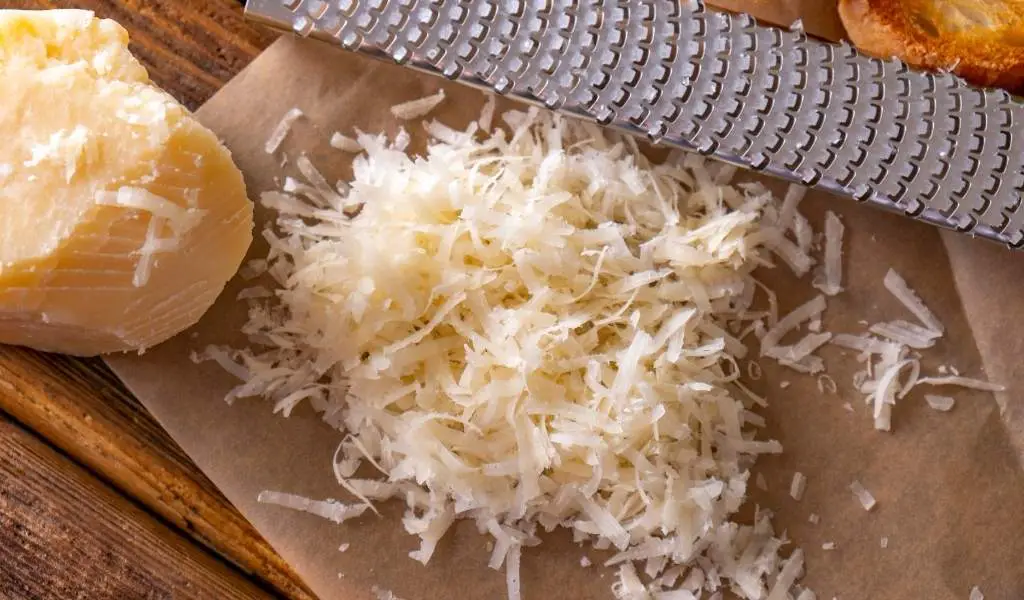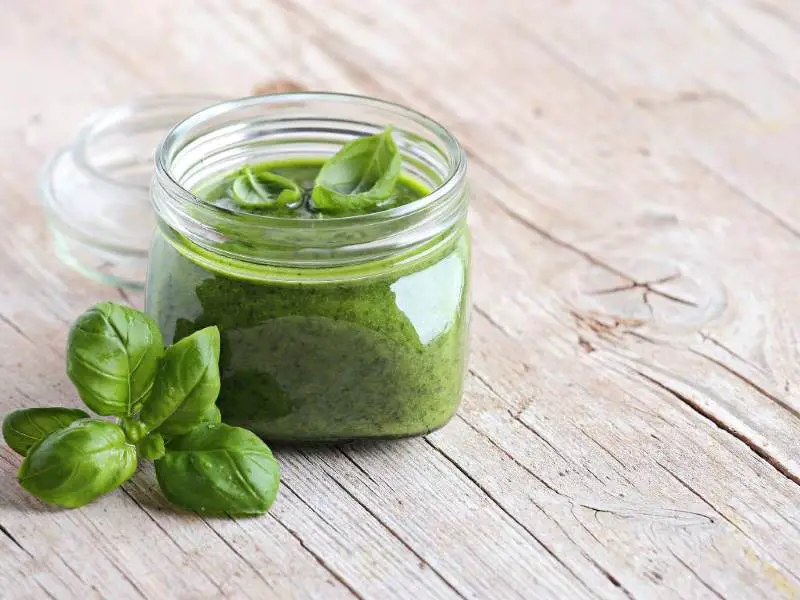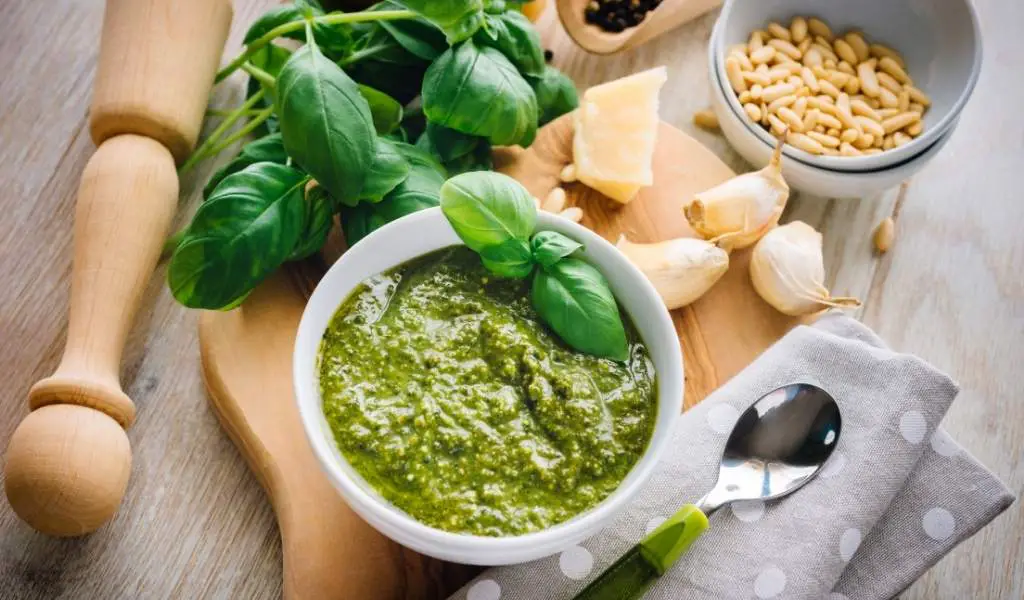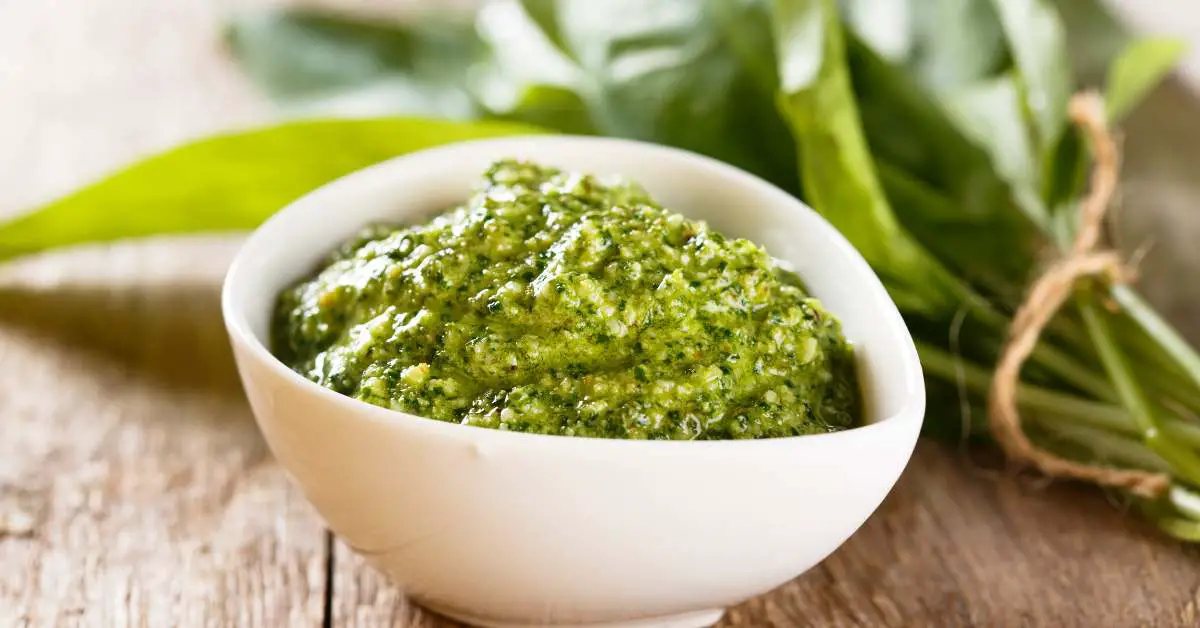Is pesto low histamine? Let’s delve into the world of pesto and find out whether it contains histamines and whether it’s likely to worsen histamine intolerance symptoms.
When you have histamine intolerance, the goal is to avoid foods that are high in histamine and those that cause your own immune cells, called mast cells, to release more histamine. But what about pesto?
In short, traditional pesto that you buy at the grocery store is not low in histamine because it contains parmesan cheese, a type of aged cheese that accumulates histamine as it ages.
However, other ingredients in pesto are low histamine, healthy, and have anti-inflammatory properties, making them beneficial if you have histamine intolerance.
What Is Pesto?
Pesto is a magical blend of flavors that originates from Italy. Imagine fresh basil, pine nuts, garlic, Parmesan cheese, and olive oil all coming together to create a uniquely delicious sauce.
When these ingredients meld, it turns into a beautiful green paste with a mix of herby, nutty, and tasty goodness.
People love putting pesto on pasta, veggies, and even sandwiches. It’s like adding a touch of Italian yumminess to your food.
Does Pesto Contain Histamines?
Since we know each component of pesto, we can now get a better idea of whether it’s high in histamine. The key ingredients, as mentioned, are:
- Parmesan cheese
- Garlic
- Olive oil
- Pine nuts
- Fresh Basil
Now, let’s look at each ingredient, so we can determine whether traditional pesto is high in histamine and whether it’s safe to eat on a low-histamine diet.

Is Parmesan Cheese High Histamine?
First, parmesan cheese. If you’ve been wondering whether Parmesan cheese falls into the high histamine category, the answer is yes.
Parmesan cheese belongs to the league of aged and fermented cheeses, and these types tend to carry higher histamine levels compared to their fresher counterparts. (6)
Parmesan holds a particular distinction because of its aging process, which involves a fermentation period that allows histamine levels to accumulate.
So, while Parmesan cheese might be a culinary delight for many, if you’re dealing with histamine intolerance or mast cell activation syndrome (MCAS), tread cautiously. Aged cheeses are off the menu if you have histamine intolerance but, as you’ll soon see, homemade histamine is not.
Are Pine Nuts in Pesto High in Histamine?
Another ingredient in pesto that we should scrutinize for its histamine content is pine nuts. Fortunately, pine nuts are low in histamine, and you can enjoy them on a low-histamine diet. In fact, pine nuts offer potential health benefits.
Pine nuts are rich in pinolenic acid, a type of polyunsaturated fatty acid that helps lower LDL-cholesterol for heart health and reduce inflammation (1)
Plus, the combination of healthy fats, fiber, and protein in pine nuts is easy on your blood sugar. In addition, pine nuts stimulate the release of satiety hormones that help curb appetite. (4)
If you feel full after eating pesto or a handful of pine nuts, that’s why.
Is Olive Oil, Garlic, and Basil in Pesto Low Histamine?
Olive oil and the herbs garlic and basil are all low in histamine and have antihistamine properties, making them suitable for a low-histamine diet. Keep in mind that there’s olive oil fraud out there, though. (5)
Some unscrupulous manufacturers dilute extra-virgin olive oil with cheaper oils. Look for olive oil varieties with a certificate of authenticity, meaning it was tested by a third party and found to be pure.
Basil is another herb with natural antihistamine benefits. (3) Holy basil has the unique benefit of blocking the release of histamine from mast cells in response to allergens.
Therefore, it may be beneficial if you have seasonal allergies or histamine intolerance. Plus, like garlic, it helps counter inflammation.

Are the Herbs in Pesto Low Histamine?
Garlic is low in histamine and most people with histamine intolerance can tolerate it in moderate amounts. It also has allicin and quercetin, antioxidants, and anti-inflammatory compounds in some foods. These are ingredients that counter some of the negative effects of histamine. (2)
Therefore, garlic has some natural antihistamine properties.
Is Pesto Low Histamine? (And How You Can Make Low-Histamine Pesto)
Although most of the ingredients in pesto are low histamine, traditional pesto is not low histamine because of its parmesan cheese. However, there are workarounds.
Fresher cheeses, like mozzarella, is low histamine because they aren’t aged, like parmesan cheese. Also, mozzarella cheese pairs well with other ingredients in pesto, like basil.
The way to make low histamine pesto is to substitute mozzarella cheese in a one-to-one ratio for parmesan in your pesto recipe. It’s a simple substitution and will still give you a creamy and delicious pesto to enjoy.
Cream Cheese Is Another Low-Histamine Substitute When Making Pesto
You can also substitute cream cheese for parmesan when you make homemade, low-histamine pesto, but IMHO mozzarella cheese gives tastier and more satisfying results. You can experiment with both to see which you prefer.
If you use cream cheese as a substitute for parmesan cheese, it will affect the texture. Since cream cheese is creamier, you can compensate by using less olive oil.
Start by using half the amount of cream cheese for the amount of Parmesan cheese in a recipe and add more to adjust the taste and texture to suit your tastes.
I would also add a little more basil to perk up the flavor, as cream cheese lacks the flavor that parmesan cheese has.

Is Pesto Low Histamine?
The traditional pesto you buy in the grocery store is usually made with parmesan cheese or another aged cheese, so it’s not low in histamine. But you can still make your own pesto at home and substitute a low-histamine cheese that isn’t fermented, such as mozzarella cheese or cream cheese.
In terms of flavor, and texture, I would use mozzarella cheese, but feel free to experiment! Here’s a recipe for low-histamine pesto made with mozzarella cheese:
Ingredients:
- 2 cups of fresh basil leaves, firmly packed
- 1/2 cup of pine nuts
- 3 cloves of peeled garlic cloves
- 1/2 cup of grated mozzarella cheese
- 1/2 cup of extra-virgin olive oil
- Salt and pepper, to your taste
Instructions:
- Prepare the pine nuts by toasting them in a dry skillet over medium heat. Stir and heat them until they turn a light brown color and release a fragrant aroma.
- In a food processor, combine the peeled garlic cloves and toasted pine nuts. Pulse until they are finely chopped.
- Add the packed basil leaves to the mixture in the food processor. Continue pulsing until the basil leaves are finely chopped.
- Now, introduce the grated mozzarella cheese into the food processor. Pulse again until the ingredients are thoroughly combined.
- While the food processor is running, gradually pour in the extra-virgin olive oil. Keep processing until the pesto reaches a smooth and creamy consistency.
- Season your homemade pesto with salt and pepper to suit your personal taste.
Enjoy your freshly made basil pesto! It’s perfect for pasta, sandwiches, or as a delightful dip.
References:
- Takala R, Ramji DP, Choy E. The Beneficial Effects of Pine Nuts and Their Major Fatty Acid, Pinolenic Acid, on Inflammation and Metabolic Perturbations in Inflammatory Disorders. Int J Mol Sci. 2023 Jan 6;24(2):1171. doi: 10.3390/ijms24021171. PMID: 36674687; PMCID: PMC9861571. https://pubmed.ncbi.nlm.nih.gov/36674687/
- Arreola R, Quintero-Fabián S, López-Roa RI, Flores-Gutiérrez EO, Reyes-Grajeda JP, Carrera-Quintanar L, Ortuño-Sahagún D. Immunomodulation and anti-inflammatory effects of garlic compounds. J Immunol Res. 2015;2015:401630. doi: 10.1155/2015/401630. Epub 2015 Apr 19. PMID: 25961060; PMCID: PMC4417560.
- Singh S, Taneja M, Majumdar DK. Biological activities of Ocimum sanctum L. fixed oil–an overview. Indian J Exp Biol. 2007 May;45(5):403-12. PMID: 17569280.
- Shin S, Park S, Lim Y, Han SN. Dietary supplementation with Korean pine nut oil decreases body fat accumulation and dysregulation of the appetite-suppressing pathway in the hypothalamus of high-fat diet-induced obese mice. Nutr Res Pract. 2022 Jun;16(3):285-297. doi: 10.4162/nrp.2022.16.3.285. Epub 2021 Oct 13. PMID: 35663443; PMCID: PMC9149321. [PDF] Dietary supplementation with Korean pine nut oil decreases body fat accumulation and dysregulation of the appetite-suppressing pathway in the hypothalamus of high-fat diet-induced obese mice | Semantic Scholar
- Carranco N, Farrés-Cebrián M, Saurina J, Núñez O. Authentication and Quantitation of Fraud in Extra Virgin Olive Oils Based on HPLC-UV Fingerprinting and Multivariate Calibration. Foods. 2018 Mar 21;7(4):44. doi: 10.3390/foods7040044. PMID: 29561820; PMCID: PMC5920409.
- Madejska A, Michalski M, Pawul-Gruba M, Osek J. Histamine Content in Rennet Ripening Cheeses During Storage at Different Temperatures and Times. J Vet Res. 2018 Mar 30;62(1):65-69. doi: 10.1515/jvetres-2018-0009. PMID: 29978129; PMCID: PMC5957463. Histamine Content in Rennet Ripening Cheeses During Storage at Different Temperatures and Times – PubMed (nih.gov)

